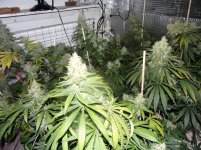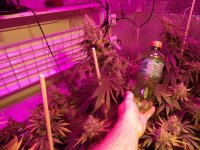I only have one eye and it has about 25% of vision left. It's very difficult for me to get good camera shots because of my handicap. 
-
ICMag with help from Landrace Warden and The Vault is running a NEW contest in November! You can check it here. Prizes are seeds & forum premium access. Come join in!
You are using an out of date browser. It may not display this or other websites correctly.
You should upgrade or use an alternative browser.
You should upgrade or use an alternative browser.
DIY and other hydroponic formulas.
- Thread starter CannaT
- Start date
Thanks, exploziv. . During the veg stage I allow for dis-charge in the drain tray, but not in flowering, The reason is that with a high cation exchange in veg. stage the plant will only take what it has receptor sites for. However, in flowering the plant should sit in the feed water without discharge for maximum nutrient saturation. The reason is due to the difference in the cation vs anion exchange. 
If soils are too acidic, phosphorus reacts with iron and aluminum and makes it unavailable to plants. Also if soils are too alkaline, phosphorus reacts with calcium and also becomes inaccessible. Phosphorus uptake is critical and must be available for the plant during flowering to produce resin. The saturation of the right nutrients and the right pH will allow the uptake of phosphorus and produce stickie and stinky flowers. . 
Looking at nutrient saturation, the size of soil particles and moisture level determines how long it takes nutrients to reach the roots. Higher water content and smaller soil particle sizes provide a straighter shot for phosphorus to contact the roots. This process is called diffusion. That is what makes the difference between watering around the organic core in the beginning and saturation in the end. In the end when I use pure rain without anything in it and add it to the long-stored phosphorus in the container, it will add more Hydrogen to the phosphorus which will make it more available. When Hydrogen links with phosphorus it becomes more available. Since rainwater has natural pH 5.5 to 5.8. it will add a lot of (H) and make sweeter flowers in the fade. .
So the last feed I used only 4 ml of micro and 8 ml of Bloom to 5&1/2 gallons or 22 liters of rainwater. I added 10 ml of cal-mag to the rainwater and then added my nutrients making only 269 ppm or 0.5 EC. 
When I could see well enough to guerrilla farm in the wilderness, I would send soil samples to the soil lab for testing each year from the new plots. One thing I noticed all the soil tests came back showing extra-high amounts of phosphorus in the soil. The tests also showed I had every nutrient I needed with the exception of nitrogen in nearly every test. Calcium was in the extra high range and gave all the soils an alkaline pH above 7 and into the low 8s. The weed-grown in these plots was like commercial always good but it lacked that top-shelf look and smell.
When I added plain peat moss to the plots the pH went down for the growing season. I dipped water out of the creek and I used pH down and lowered the pH in large trash cans of creek water to about 6.8 or 7 pH. Everything changed it was night and day difference and the buds got big and frosty and closer to top-shelf buds. I added a small amount of slow-release Nitrogen (26-0-0) in early Spring to the plots and the growth was unbelievable!!!! I just can’t tell you with words how amazing the growth was and how it changed with the added Hydrogen from lowering the pH. The soil pH was the only thing lacking. Here are some old photos of plants in veg. 
Attachments
There is a sweet spot right where the topsoil meets the clay undersoil. The CEC is highest in this area and if a plant can find it the growth is stem-busting amazing. Farmers have known this for a long time and finding one of the spots made all the difference in a successful farm and bumper crops.. The question I had was, "I wonder if I could artificially copy the same principles indoors using some method to boost the CEC in a container. There are so many variables, so many questions unanswered. I'm still lost and learning each time I grow a new cycle. I've used different boosting materials and found that using just plant old good organic soil will do the trick when inserted in the soil-less substrate. However, there are some clays that need exploring more and mixed at different ratios, and find the one that works the best mixed with the organic cores. I truly believe one can equal Deep Water Culture yields by matching the Cation Exchange Capacity using these methods. The soils I added peat to above was all clay soils.
Last edited:
Here's an update. The plants are starting to fade very well on the water with every watering. I raised the lights even higher and turned off the sidelight to simulate the end of the season to the plants, As the nutrients in the container slowly disappear the plants should go into panic mode and push the output of resin production to try to save the calyx from drying out and dying. I'm not allowing any discharge or run-off yet, only water in and nothing out. With a reduction of light and nutrients at the same time, the plant should fade fast. Here's are some photos of today. 
Attachments
One of the nice things about low ppm feed with every watering is the fade is quick and easy. No flushing is needed using this method however the results will be the same as flushing or maybe even better. The watering day a couple of days ago, I used 9 ml of cal-mag to 5 gallons or (22liters) of water giving me 90 ppm (0.2EC) total water. . Today I will be using only 5 ml of cal-mag giving me only 50 ppm (0.1EC) water. As I lower the cal-mag ppm in the water the pH will fall in a range that phosphorous is very available and should frost the plants even more. The lower pH will allow linking between Hydrogen and phosphorous making it available. Most of the side branches are sagging like they have seeds from heavyweight. No seeds though, Heres today,
Attachments
The plants are starting to take mobile nutrients from the leaves and use them for food now. One of the good things about starting a fade a little early is when the leaves drop the light will travel down deeper in the canopy. Here are some more photos from today. 
Attachments
This is important and should be watched out for on a watering day, I have 6 plants to water, and out of those 6, only 4 are using water. The other two plants are still holding their water from the last watering, and if I watered those 2 now, I would be making a big mistake. In the END, plants don’t take water as they did before and you have to watch it closely. Don’t water just because its a watering day, only water when the plants are ready. This is the place where growers are hit with mold, which can come in and hurt your plants. I will have to watch each plant very closely and leave the routine watering sequence, Using clean water now makes it so easy to water one pot a day or 4 pots a day. 
Water management is so important now and the amount of water my plants need will change from watering to watering. When the buds start getting thick and dense the water can’t leave the plant like before. It's not a good idea to flood the pot to the max weight on the 3[SUP]rd[/SUP] day anymore. Just a couple of cups now, where before I was giving 6 cups to the plant. I’m still not allowing dis-charge or run-off only fresh water in only and nothing out the bottom. If I allowed water to run out with every watering at this point, I would be over watering and get mold. No need to test pH or EC anymore. So easy from now on using water without fertilizer. 
Attachments
Remember this is for newbies only and not for advanced growers
Using a low ppm feed with every watering causes the plant to push a lot of feed water through its system from veg to early flowering. The more the water the more the food, the more the transpiring the more the growth. However, when I give the plant just plain water for a while it stops pushing the water like it did when it had fertilizer in it. Transpiration slows almost to a stop because there’s not anything in the water worth moving anymore. If I watered my plants anyway, I would over-water them, because the plants "ain’t moving any water". When the plant leaves turn yellow and start to fall that’s when this happens. If I don’t respect this plant process It can bite me on the ass with diseases like mold or root rot. So I’m cutting the amount of water to at least 50% or less today to the ones that are taking it.
Today, I have one plant that takes no water at all now she's completely turned off. She is a sixty-day flower and at the end (28Nov). If I give her anything this late it will bite me on the ass later. I've screwed up many times in the past not respecting this end process of the plant's metabolism. If a plant doesn't use the water don't give any more at all. 
Attachments
It's almost over now. I will post some buds after harvest. 
You hear a lot of talk about gov regulations and not using pesticides. However, in my experience, many home growers and commercial growers more commonly overuse and misuse fertilizers. The application of too much fertilizer not only affects the environment we live in, it also damages the plants we are trying to grow. Chemical and biosolid fertilizers are considered hazardous waste, and should never be tossed in the trash or down the drain because they contaminate local water supplies.






































